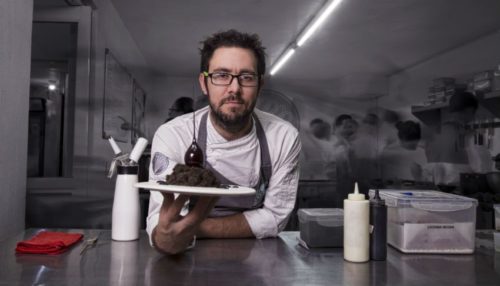Jesús Escalera, the 32-year-old award-winning chef behind La Postrería restaurant in Mexico, is the force behind a new trend in the pastry world – although he prefers to call it the ‘sweet world’ or ‘dessert world’, as the word ‘pastry’ is too narrow for the task he has undertaken.
[otw_shortcode_tabslayout tabs=”2″ tab_1_title=”Simplified Chinese” tab_1_content=”对很多人来说,饭后少了甜点,总嫌不够满足。然而,甜点出现的时间可以不只是一餐的结尾,其味道也不一定非得甜滋滋。西班牙主厨 Jesús Escalera 就打破了这些既定印象。
Escalera 去年十月获得拉丁美洲五十最佳餐厅颁发「最佳甜点师」奖项。他在墨西哥瓜达拉哈拉开了一间甜点餐厅 La Postrería,除了贩售蛋糕、马卡龙、巧克力,也提供一套六道或十道的品尝菜单 (tasting menus),一道道全是甜点。
听起来甜腻吓人?其实不太需要担心,根据《The World’s 50 Best Restaurant》报导,Escalera 的甜点不只有甜味或酸味,也尝得到苦味、咸味、辣感以及烟熏气味,而这些都来自于香菜、橄榄、尤加利树…较不常见于甜食的食材。
打破甜咸界线的做法使 Escalera 脱颖而出,但他并不是为了哗众取宠,而是有意打破饮食文化长久以来赋予食材的既定印象,回归食材本身的风味。「人们往往觉得胡椒是用来调味咸食,而肉桂则是用于甜点,但这么想是错的。一旦跳脱这些框架思考,就能为甜点打开无限可能。」
也就是说,即使不嗜甜的人,也可能成为 La Postrería 的座上宾。 「我父亲不吃甜点。饭后他只想喝浓缩咖啡,而咖啡是苦的。那为什么我们不能做苦味甜点?而有些国家习惯在吃饱后,来一盘浓郁咸鲜的起司。所以,我们的甜点一定有甜味,但也多了更多酸、苦、辣或咸。」他认为这不算创新,只是在寻找风味背后的逻辑。
” tab_2_title=”Traditional Chinese” tab_2_content=”
對很多人來說,飯後少了甜點,總嫌不夠滿足。然而,甜點出現的時間可以不只是一餐的結尾,其味道也不一定非得甜滋滋。西班牙主廚 Jesús Escalera 就打破了這些既定印象。
Escalera 去年十月獲得拉丁美洲五十最佳餐廳頒發「最佳甜點師」獎項。他在墨西哥瓜達拉哈拉開了一間甜點餐廳 La Postrería,除了販售蛋糕、馬卡龍、巧克力,也提供一套六道或十道的品嚐菜單 (tasting menus),一道道全是甜點。
聽起來甜膩嚇人?其實不太需要擔心,根據《The World’s 50 Best Restaurant》報導,Escalera 的甜點不只有甜味或酸味,也嚐得到苦味、鹹味、辣感以及煙燻氣味,而這些都來自於香菜、橄欖、尤加利樹…較不常見於甜食的食材。
打破甜鹹界線的做法使 Escalera 脫穎而出,但他並不是為了譁眾取寵,而是有意打破飲食文化長久以來賦予食材的既定印象,回歸食材本身的風味。「人們往往覺得胡椒是用來調味鹹食,而肉桂則是用於甜點,但這麼想是錯的。一旦跳脫這些框架思考,就能為甜點打開無限可能。」
也就是說,即使不嗜甜的人,也可能成為 La Postrería 的座上賓。「我父親不吃甜點。飯後他只想喝濃縮咖啡,而咖啡是苦的。那為什麼我們不能做苦味甜點?而有些國家習慣在吃飽後,來一盤濃郁鹹鮮的起司。所以,我們的甜點一定有甜味,但也多了更多酸、苦、辣或鹹。」他認為這不算創新,只是在尋找風味背後的邏輯。
“][/otw_shortcode_tabslayout]
English translation:
For many people, not having desserts after dinner is not satisfying enough. However, the time when desserts appear can be more than just at the end of a meal, and the taste does not necessarily have to be sweet, either. The Spanish chef Jesús Escalera broke these established impressions.
Escalera was awarded the “Best Pastry Chef” award in the 50 Best Latin American Restaurants in October last year. He opened a dessert restaurant, La Postrería, in Guadalajara, Mexico. In addition to selling cakes, macarons, and chocolates, he also offers six or ten courses of tasting menus, all consist of desserts.
Does the word “sweet” make you sick? In fact, you don’t need to worry. According to The World’s 50 Best Restaurant, Escalera’s desserts are not only sweet or sour, but also taste bitter, salty, spicy and smoky, all from coriander, olives, eucalyptus…..the ingredients that are less common in sweets.
Breaking the “line of sweet and salty” made Escalera stand out, but he didn’t want to be sensational, but instead intended to break the established impression of the food culture that has long been given to the ingredients and return to the flavor of the ingredients themselves. “People often think that pepper is used for seasoning and salty food, while cinnamon is used for dessert, but it is wrong to think so. Once you break away from these thinking frames, you can open up unlimited possibilities for dessert.”
In other words, even those who do not eat sweets, may become a guest of La Postrería. “My father doesn’t eat dessert. After dinner, he only wants to drink espresso, and also the coffee is bitter. In that case, then why can’t we make bitter desserts? And some countries are used to eating a thick and savory cheese after eating. Therefore, there is not only sweet taste in our desserts (which is a must), but also sour, bitter, spicy or salty.” He thinks this is not an innovation, he is just looking for the logic behind the flavor.
The article is rewritten from here to suit the level of readers. photo is taken from here.

